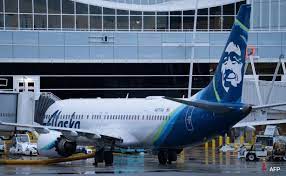WASHINGTON: The US regulators on Saturday temporarily grounded certain Boeing 737 MAX 9 jetliners for safety checks following a cabin panel blowout that forced a new Alaska Airlines jet carrying passengers to make an emergency landing.
A piece of fuselage tore off the left side of the jet as it climbed following take-off from Portland, Oregon, en route to Ontario, California, on Friday, forcing pilots to turn back and land safely with all 171 passengers and six crew on board.
The plane had been in service for just eight weeks.
The FAA’s decision is well short of the global grounding of Boeing MAX jets almost five years ago following two crashes that killed nearly 350 people. Still, it is another blow to Boeing as it tries to recover from back-to-back crises over safety and the pandemic under heavy debts.
The FAA did not rule out further action on Saturday as a probe began into the apparent structural failure, which left a rectangular hole in an area of fuselage reserved for an optional extra door but which is disactivated on Alaska’s aircraft.
The Boeing 737 MAX 9s fitted with a special door replacement “plug” cannot fly until they are inspected and repaired if necessary, the Federal Aviation Administration said.
“The FAA is requiring immediate inspections of certain Boeing 737 MAX 9 planes before they can return to flight,” FAA chief Mike Whitaker said.
National Transportation Safety Board investigators were expected to arrive on the scene on Saturday afternoon.
Social media posts showed oxygen masks deployed and a portion of the aircraft’s side wall missing.
A section of the fuselage reserved for the optional door had vanished, leaving a neat door-shaped gap. The seat next to the panel, which contained an ordinary window, had been unoccupied.
Emma Vu, a passenger on the Alaska flight, told CNN she awoke to the plane “just falling, and I knew it was not just normal turbulence because the masks came down and that’s when the panic definitely started to set in.”
The extra door is typically installed by low-cost airlines using extra seats that require more paths for evacuation.
However, those doors are permanently “plugged,” or deactivated, on jets with fewer seats, including those of Alaska Airlines.
The fuselage for Boeing 737s is made by Kansas-based Spirit AeroSystems, which separated from Boeing in 2005. Spirit manufactured and installed the particular plug door that suffered the blowout, a source told Reuters on Saturday. The company did not respond to a request for comment.
The FAA said its inspection directive covers 171 MAX 9 airplanes but did not say how many planes need new inspections or what the precise inspection requirements are.
The MAX 9 represents about 220 of the 1,400 MAX jets delivered so far and most of them have the disactivated door, meaning they are potentially covered by the order.
Boeing said it supported the FAA decision.
Some foreign regulators including China sought details on the incident, a person familiar with the matter said. Bloomberg reported earlier that China, the first country to ground MAX flights in 2019, was considering whether to take action.
MAX planes were grounded worldwide for 20 months following the crashes in Ethiopia and Indonesia linked to poorly designed cockpit software.
Alaska Airlines and United Airlines are the only U.S. carriers using the MAX 9, according to aviation data provider Cirium. Alaska canceled 154 flights on Saturday, or 20% of scheduled trips, while United canceled 80 flights or 3% of departures.
Alaska said earlier it had voluntarily grounded its fleet of 65 Boeing MAX 9 jets for checks. It said 18 planes were inspected during recent maintenance and are cleared for flight, while the remaining inspections are expected to take several days.
United said it suspended service on about 45 MAX 9s for inspections and expected 60 flight cancellations Saturday.
Boeing is awaiting certification of its smaller MAX 7 and larger MAX 10 which are needed to compete with the Airbus A321neo model.
Boeing has suffered numerous production issues on the MAX planes in the years since the crashes. Last week, Boeing said it was urging airlines to inspect all 737 MAX airplanes for a possible loose bolt in the rudder control system.
Flight 1282 had reached just over 16,000 feet when the blowout happened, according to FlightRadar24. “We’d like to get down,” the pilot told air traffic control, according to a recording posted on liveatc.net.
“We are declaring an emergency. We do need to come down to 10,000,” the pilot added, referring to the initial staging altitude for such emergencies, below which breathing is considered possible for healthy people without extra oxygen.
“I can’t imagine what these passengers experienced,” said Anthony Brickhouse, an air safety expert at Embry-Riddle Aeronautical University. “The wind would be rushing through that cabin. It was a probably pretty violent situation, and definitely a scary situation.”
The European Union Aviation Safety Agency adopted the FAA MAX 9 directive but noted no EU member state airlines “currently operate an aircraft in the affected configuration.” A British air safety regulator said it would require any 737 MAX 9 operator to comply with the FAA directive to enter its airspace.
Panamanian carrier Copa Airlines said it had temporarily grounded 21 737 MAX 9 aircraft and said it “expects to return these aircraft safely and reliably to the flight schedule within the next 24 hours,” and said some delays and cancellations are expected.


